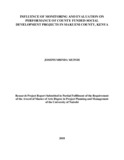| dc.contributor.author | Muindi, Joseph Mbinda | |
| dc.date.accessioned | 2018-10-25T08:03:30Z | |
| dc.date.available | 2018-10-25T08:03:30Z | |
| dc.date.issued | 2018 | |
| dc.identifier.citation | Master of Arts Degree in Project Planning and Management | en_US |
| dc.identifier.uri | http://hdl.handle.net/11295/104401 | |
| dc.description | Master of Arts Degree in Project Planning and Management | en_US |
| dc.description.abstract | It has so far been established that monitoring and evaluation of projects is both necessary and warranted. However, there is need to consider the factors that influence the monitoring and evaluation process particularly in county governments where massive resources and projects have both in injected and initiated. Thus, the purpose of the study undertook a detailed analysis of influence of Monitoring and Evaluation on Social development projects’ performance in Makueni County, Kenya. It specifically sought to establish how level of competence in monitoring and evaluation; resources availability for monitoring and evaluation; stakeholder participation in monitoring and evaluation; and stakeholder attitude on monitoring and evaluation influence social development projects’ performance in Kibwezi West Sub-County. Expectancy theory, theory of planned behavior and the stakeholders’ theory gave a hinge to the study. The study employed a descriptive research design and targeted the 45 County government staff drawn from Kibwezi West Sub-County and 200 Project management committee members. Census procedure was used to get all the 45 staffers while simple random sampling was used to select 60 PMC members. Questionnaires were used to collect data with reliability tested using a pilot study in neighboring Kibwezi East sub-county. To thus determine the instrument’s content validity, the research supervisor considered the instrument’s content and counseled the study researcher. Quantitative data was analyzed with the significant use of descriptive analysis together with the inferential based analysis of correlation and regression analyses to ascertain the score that became relevant to the monitoring unit of the county. The study results presents: level of competence (β1 = .383 p<0.01), resource availability (β2 =.181 p<0.01), and stakeholder participation (β3 =.293 p<0.01) together with stakeholder attitude (β4 =.312 p<0.01) in monitoring and evaluation had a significantly negative influence on county funded social development projects performance. The study thus recommends that: The Kibwezi West Sub-county should invest in training its staff and the PMC Members in monitoring and evaluation. They should perform resource mobilization to acquire physical, human and financial resources that would support monitoring and evaluation of the county funded social development projects. Also, they should devise an inclusion policy that would enhance effective stakeholder participation in monitoring and evaluation of the county funded social development projects. The Kibwezi West Sub-county should employ both extrinsic and intrinsic motivation to enhance stakeholder attitude towards monitoring and evaluation of the county funded social development projects. Finally, the government should device and put into practice feasible strategies that edges out unnecessary and unhealthy corruption and one that ensures that the county projects are completed in time, within cost and with top quality finish | |
| dc.language.iso | en | en_US |
| dc.publisher | School of Open and Distance Learning, University of Nairobi | en_US |
| dc.rights | Attribution-NonCommercial-NoDerivs 3.0 United States | * |
| dc.rights.uri | http://creativecommons.org/licenses/by-nc-nd/3.0/us/ | * |
| dc.subject | Social development projects | en_US |
| dc.title | Influence of monitoring and evaluation on performance of county funded social development projects in Makueni County, Kenya | en_US |
| dc.type | Thesis | en_US |
| atmire.cua.enabled | | |



